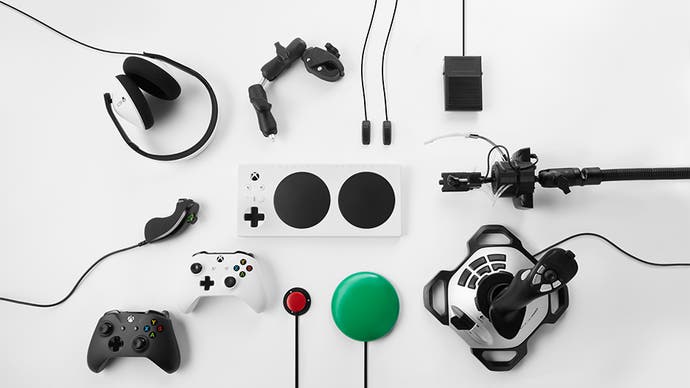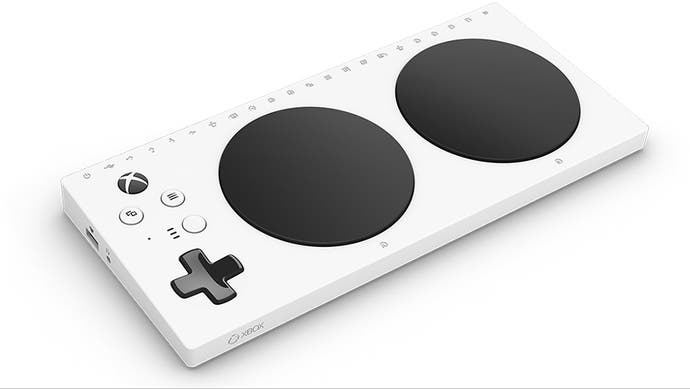How gamers with disabilities shaped the Microsoft Adaptive Controller
"This thing felt like a love letter to me.”
Solomon Romney was 15 when he realised video games had finally beaten him. Born with no fingers on his left hand, he'd managed just fine through the 1980s, hanging out in the arcades, benefiting from the limited inputs of those classic coin-ops with their one-stick-two-button set-ups. "My dad was a late night talk show host so I didn't spend much time with him," he explains. "But gaming was something we had. We'd go to the movies, then we'd go to arcades. That was where I was happiest, that was where I realised gaming was an empowering activity. It's always been personal for me."
But then in the mid-1990s, games became more complex, the control systems more intricate - especially on console titles. Romney had a PlayStation and he'd managed to fudge his way through with most games he wanted to play - until Squaresoft's acclaimed title, Vagrant Story. "It was one of the first RPGs to use chaining so it meant lots of button combinations in order to win," he said. "I worked my way through the whole thing, I struggled, I adapted, I came up with new methods, but I got to the final boss, and I died... so I restarted, I died, I restarted, I died... I went through that cycle for hours, I tried absolutely everything I could. But then I reached a point where I suddenly realised... it's just not going to happen for me. The shape of that controller and the shape of my hands didn't match, I was physically unable to complete a video game. It was a revelatory moment."
Romney is a learning specialist with Microsoft and a year ago he was brought in to test an early prototype of the Xbox Adaptive Controller, the disability-focused joypad, announced last week. To get the device right, the company made an important decision: they weren't just going to consult with occupational therapists and charities like AbleGamers ans SpecialEffect during the development process, they were going to include gamers with disabilities from the outset. For Microsoft it was a radical move - it had never invited the gaming community into a hardware design before. The company built an Inclusive Tech Lab at its Redmond campus, a tennis court-sized room complete with demo stations, a lounge area with 70-inch TV and a conference space, where gamers and experts have been brought in for "inclusive design sprints". Everything is disability focused - the desk heights are adjustable for wheelchairs, the brightness and colour of the lighting can be customised for people with visual sensitivities, even the coffee machine has braille controls. "It's an embassy for games," states Evelyn Thomas, Microsoft's accessibility programme manager for Xbox. "We want people to intentionally include disabled gamers in our products".
A key element of the Microsoft Adaptive Controller that has come from working directly with disabled gamers themselves is its user flexibility. The open nature of the design, coupled with the highly customisable app used to define controller configurations, means users have a lot of room to experiment and work out their own set-ups. In this way people are afforded a sense of agency and control. Mike Luckett was a highly competitive gamer until 2011 when a motorcycle accident left him with a severe spinal injury. He can move his arms but has no dexterity in his fingers. As a volunteer for the charity Warfighters Engaged, which helps to get injured military personnel back into gaming, he has been testing the Xbox Adaptive Controller for over a year.
"When you start out, there's definitely an adjustment period," he says. "You just try to figure out what your configuration will be because everybody has different abilities and there are different games". He shows off his Overwatch set-up which employs a traditional controller (via the Xbox Co-Pilot function), but with the left trigger function swapped to an AbleNet Big Red Switch, which he rests just beneath his wrist, while a small Ultra Switch, placed further up his arm, acts as the X button.
"Overwatch characters have a lot of mobility and being able to do that just on the controller by myself, it wouldn't have been possible," he explains as his character, Junkrat, performs a series of elaborate jumps on the screen. "Being able to assign the buttons gives me so many options to play with, especially with characters that have different abilities. Before this I was just trying to use the standard controller - all the other controllers on the market were extremely expensive. For somebody that has a disability... think about having to pay extra just to do something an able bodied can do - it seems really unfair." Luckett is now working on his own set-up for PUBG, getting the aim-down-sights and jump functions just right. "The good thing about the adaptive controller is you can customise the set-up for whatever game you're playing. It's really funny when people found out I have a disability and can't use my hands. It shows that anybody can be competitive and destroy people."
Vivek Gohil has played video games since he was a child, but by his twenties, they were slipping away from him. He was born with Duchenne Muscular Dystrophy, a life-limiting hereditary muscle wasting condition, which affects all muscles in his body including the heart, lungs and the digestive system. For years, he improvised his own ways to keep gaming; placing sponges under his wrists so he could hold a controller, or simply not using features of games, like the slow-mo ability in Red Dead Redemption. But as the condition worsened, his fixes became untenable. "The worst day for me was buying a PS4 because my fingers were moulded to the PS3 and Xbox360 controller," he says. "This made me decide to play slower strategy games like XCOM 2 and I ended up watching Youtube game walkthroughs of games I wish I could play. It was heartbreaking being reminded of my disability when gaming is meant to be inclusive."

Via SpeciaEffect, a UK charity which builds and distributes custom controllers, and which consulted with Microsoft on its adaptive prototype, Vivek was another early tester. Once again, he found that the flexibility of the design gave him a huge amount of agency over the set-up. "With Forza, I used the left analog stick of a regular controller via the co-pilot accessibility feature to steer the car. Connected to the Xbox Adaptive Controller I had a chin switch to accelerate and right head switch for braking mounted on my wheelchair. I had two knee switches stuck to the bottom of the table to press the Rewind button and Challenge button. Before I tested the device, I was completely unable to play using a regular controller but when I found the perfect switch setup I managed to win multiple races. It was an amazing experience to hand me back the controller I never thought I'd ever hold again."
There is one other thing Microsoft learned from working directly alongside gamers with disabilities - the importance of aesthetics. It is easy to assume that the functionality of a device is enough, but it isn't. "The fact that it looks and behaves like an Xbox controller is a huge deal for my patients because that was what they used before they were injured," says Erin Muston-Firsch, an occupational therapist at the Craig Hospital in Denver, which specialises in spinal and brain injuries. "One of the things that leads my patients to abandon devices is that they look like something for disabled people, they look big, awkward and unappealing. When I put the Xbox Adaptive Controller in front of people they'd say wow it looks like a controller, that was a good feeling."
This has been a long time coming. The video game industry is only just beginning to understand its responsibilities to gamers who don't fit into the able-bodied metric that we sometimes take for granted. This is, after all, a commercial industry and that can mean a massive focus on the supplying the majority. But with two billion people now playing video games, and one billion people in the world living with some kind of disability, the ramifications of non-inclusive design are becoming more pressing. What Microsoft has shown is that inclusive design from the outset can have life-changing results, especially if it is guided by genuine consultation with those affected. "The disabled community has a saying," points out Evelyn Thomas. "Nothing about us without us."
Solomon Romney, the 80s arcade brat, who felt left behind by gaming puts it more prosaically. During a demo event for the controller, he's spent the last twenty minutes telling his story, but finally he goes quiet for a few moments and shrugs. "As a gamer with a disability, this thing felt like a love letter to me," he says.










